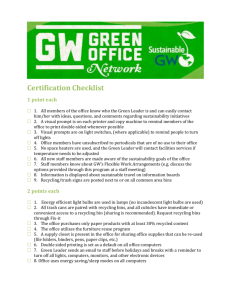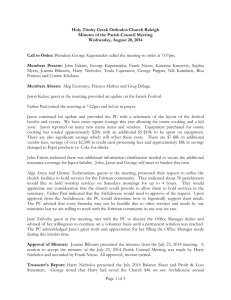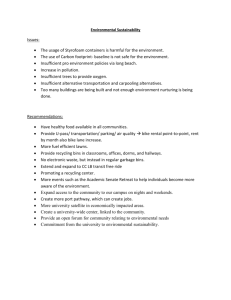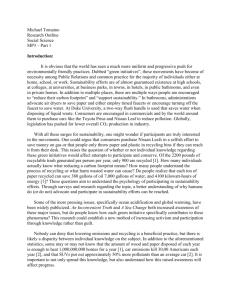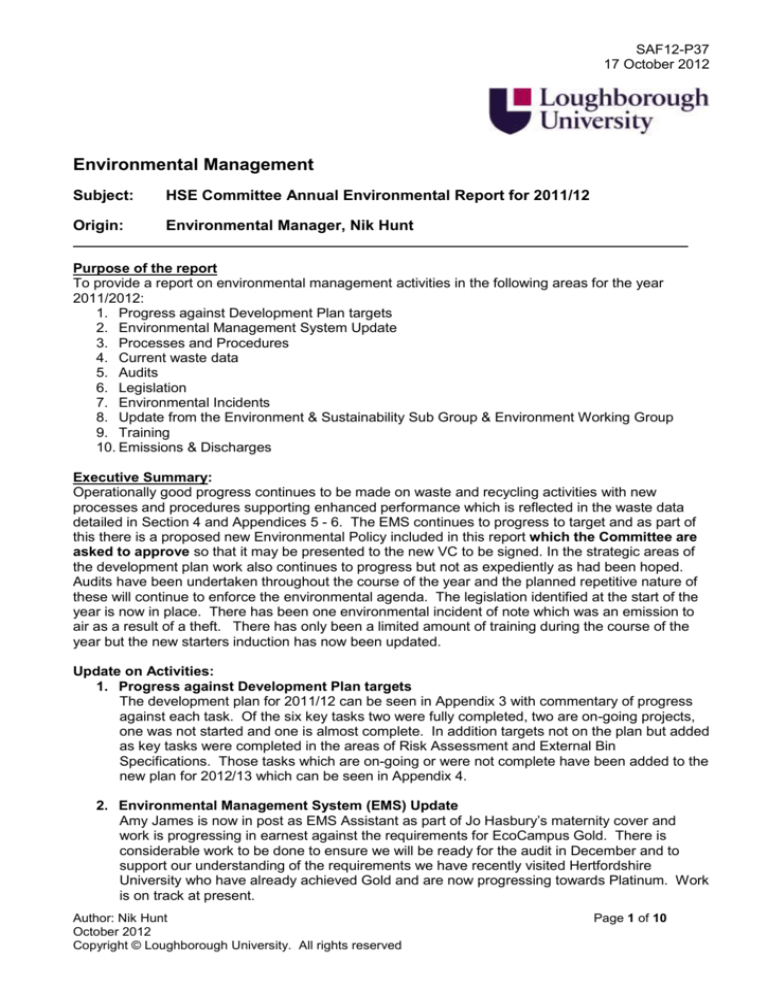
SAF12-P37
17 October 2012
Environmental Management
Subject:
HSE Committee Annual Environmental Report for 2011/12
Origin:
Environmental Manager, Nik Hunt
Purpose of the report
To provide a report on environmental management activities in the following areas for the year
2011/2012:
1. Progress against Development Plan targets
2. Environmental Management System Update
3. Processes and Procedures
4. Current waste data
5. Audits
6. Legislation
7. Environmental Incidents
8. Update from the Environment & Sustainability Sub Group & Environment Working Group
9. Training
10. Emissions & Discharges
Executive Summary:
Operationally good progress continues to be made on waste and recycling activities with new
processes and procedures supporting enhanced performance which is reflected in the waste data
detailed in Section 4 and Appendices 5 - 6. The EMS continues to progress to target and as part of
this there is a proposed new Environmental Policy included in this report which the Committee are
asked to approve so that it may be presented to the new VC to be signed. In the strategic areas of
the development plan work also continues to progress but not as expediently as had been hoped.
Audits have been undertaken throughout the course of the year and the planned repetitive nature of
these will continue to enforce the environmental agenda. The legislation identified at the start of the
year is now in place. There has been one environmental incident of note which was an emission to
air as a result of a theft. There has only been a limited amount of training during the course of the
year but the new starters induction has now been updated.
Update on Activities:
1. Progress against Development Plan targets
The development plan for 2011/12 can be seen in Appendix 3 with commentary of progress
against each task. Of the six key tasks two were fully completed, two are on-going projects,
one was not started and one is almost complete. In addition targets not on the plan but added
as key tasks were completed in the areas of Risk Assessment and External Bin
Specifications. Those tasks which are on-going or were not complete have been added to the
new plan for 2012/13 which can be seen in Appendix 4.
2. Environmental Management System (EMS) Update
Amy James is now in post as EMS Assistant as part of Jo Hasbury’s maternity cover and
work is progressing in earnest against the requirements for EcoCampus Gold. There is
considerable work to be done to ensure we will be ready for the audit in December and to
support our understanding of the requirements we have recently visited Hertfordshire
University who have already achieved Gold and are now progressing towards Platinum. Work
is on track at present.
Author: Nik Hunt
October 2012
Copyright © Loughborough University. All rights reserved
Page 1 of 10
Environmental Policy review – as part of the work on the EMS we have reviewed the
Environmental Policy. It was felt that it was lacking in some areas and that the structure could
be improved upon. Given this and the fact that the current version is signed by Prof Shirley
Pearce it was felt that there was an opportunity to amend the policy and seek authorisation
from the new VC, Professor Robert Allison. The proposed new Policy is detailed in
Appendix 1 and the HSE Committee are asked to approve this to be taken to Professor
Allison.
3. Processes and Procedures
The new mobile phone recycling process has been introduced.
The new toner cartridges recycling process has been introduced.
A trial polystyrene recycling process is being tested in two key locations with a third
due to start shortly.
The Waste Guidance Notes are still being developed.
The work on the “Management of Hazardous Materials” guidance document is
progressing with the Health & Safety Manager and the next step will be consultation
with key DSO’s and is due to start shortly.
4. Current waste data
The table in Appendix 5 details the HESA waste return from 2009/10 and the final submission
made for 2010/11 along with the data for 2011/12 which will form the submission later this
year. As this includes construction waste now, which distorts the overall figures an additional
table is shown in Appendix 6 which details the data excluding construction waste. From this it
can be seen that:
We recorded a higher waste figure overall, up 283.5 tonnes or 15.7%, - at present this
is I believe still attributable to the fact that we are recoding data not previously
recorded.
The overall recycling rate was 71.8% up 15.8% and means we have surpassed the
waste strategy target of 70%. This now needs to be maintained with a target of 75%
by 2015.
Diversion from landfill (i.e. Used to Create Energy) also increased by 6.5% to 17.5%
surpassing the strategy target of 15%. This now needs to be maintained with a target
of 20% by 2015.
Two other key recycling targets exist within the waste strategy
o To increase on campus recycling by 10% in 2011/12 and by 5% year on year
until 2015. This target was narrowly missed with on campus recycling
increasing by 7% from 42% to 49%.
o To increase recycling in halls by 10% in 2011/12 and by at least 5% year on
year until levels on campus reflect local averages (current target for
Charnwood Borough Council is 46%). This target was significantly passed with
halls recycling increasing from just 19% in 2010/11 to 40% in 2011/12,
justifying the role of the Environmental Assistant who focuses on the Halls
Environment League.
Unfortunately the targeted reduction in food waste of 5% (10 tonnes) was not met and
in fact food waste increased by 30 tonnes although after adjustments for the collection
of waste from additional facilities the net increase was 10.5 tonnes. We are now
working with WRAP and their Love Food Hate Waste Team to tackle this and are the
first University to do so.
5. Audits
During the year environmental audits have been undertaken across all areas at least
once and recently we have revisited the Facilities Management yard and main waste
compounds, Civil and Building Labs and Department of Aeronautical and Automotive
Author: Nik Hunt
October 2012
Copyright © Loughborough University. All rights reserved
Page 2 of 10
Engineering. There have been no major non conformances but a number of minor
ones which are in the process of being followed up.
The audit schedule for the next 12 months is detailed in Appendix 2
Risk Assessments (RA’s) – Following the
RA’s undertaken earlier in the year,
enclosure for the 1100 bins have now
been installed in 8 key locations to
mitigate the fire risk of these bins being
moved close to building entrances. Three
locations exist where this risk still exists
(Hazlerigg, Rutland and HIPAC and the
plan is to remove these altogether and
replace them with an FEL skip. This has
been agreed but is awaiting the
landscaping project between the three
buildings.
6. Legislation
There have been two new changes to legislation during the course of the year which have
previously been notified to the committee, both coming into effect in April 2012, they were:
An amendment to the Controlled Waste Regulations 1992 which reclassified certain
properties as commercial and not household thus enabling local authorities to make
charges for collection and disposal. This has not affected our relationship with
Charnwood Borough Council and the collection of recyclables from the halls of residence
but may do so when the current contract ends at the end of 2013/14.
An amendment to the Environmental Permitting Regulations which allows the
Environment Agency to issue fines and use other civil penalties for environmental
permitting offences as an alternative to prosecution. This will only affect us if we are
found to be in breach of any permitting compliance requirements.
7. Environmental Incidents
There have been three environmental incidents during the course of the year, two of which
have previously been mentioned and involved contractors spilling items from waste loads,
incidents which posed a greater H&S risk than environmental risk. The third incident has not
previously been reported as investigations were on-going and involved an emission to air. It
occurred during the demolition of the previous Bridgeman Building and involved the emission
of the refrigerant gas R22. Despite the site being surrounded by a 2.4m hoarding and classed
as secure, thieves were able to gain entry and steal a quantity of copper piping including
some which were part of the air conditioning systems. It was a result of this that an unknown
quantity of the R22 was emitted to air. As a result of this incident new procedures are now in
place regarding the early removal of refrigerants from buildings due for demolition and
increased security for such buildings.
8. Update from the Environment & Sustainability Sub Group & Environment Working
Group
There are no specific items to report from either of these groups that haven’t already been
mentioned. The Sustainability Strategic Group however has requested an update to the
structure of Sustainability and Environment Groups and this is currently under way. The
proposed structure will see a reduction in the number of groups and meetings and a greater
senior management presence at all levels.
9. Training
Author: Nik Hunt
October 2012
Copyright © Loughborough University. All rights reserved
Page 3 of 10
There has been no specific training since the last HSE Committee meeting although my
studies towards my MSc in Environmental Management are nearing completion (due to be
completed by Christmas). The University Induction has however been updated with improved
Sustainability content although this still falls short of what we believe should be being
delivered to new starters. We are currently looking at how we can improve on this and how
we can deliver greater awareness to existing staff.
10. Emissions & Discharges
Some progress has now been made on the actions pertaining to the report relating to
Emissions to Air and Discharges to Water. However a number still remain which will need to
be added to the development plan for 2012/13, they are:
A need to create registers for Air Conditioning, Refrigeration and Fire equipment
containing CFC’s and/or HCFC’s and to identify suitable replacements where necessary.
A need to update drainage and interceptor plans
The supply of spill kits and drain mats should be reviewed across the campus to ensure
spill kits are available within any storage areas and that drain mats are available to areas
where there is a risk of leaking or spilling containers to allow substances to enter drains
A recommendation that the University works with the Fire Service to develop a Firewater
Incident Plan
The inclusion of actions in the event of spillage, leak or other emission or discharge of
materials as part of the major incident plan or the creation of a Specific Environmental
Major Incident Plan.
A requirement to undertake both general training on Emissions and Discharges as well as
specialist training on Ozone Depleting Substances
Monitoring and water quality testing of Burleigh Brook as well as the pond and lake at
Holywell Park
Additional achievements:
Environment Day – held March 23rd as part of Sustainability Team
Sustainability Strategy – development of Vision and Mission
Author: Nik Hunt
October 2012
Copyright © Loughborough University. All rights reserved
Page 4 of 10
Appendix 1: Draft Environmental Policy Revision
ENVIRONMENTAL POLICY
Loughborough University has one of the largest single site campuses in the UK, educates in excess of
16,000 students and employs over 3000 members of staff. In providing high quality educational, research
and workplace facilities we recognise that many of our activities have environmental impacts which are, or
have the potential to be, significant. We therefore recognise the importance of embedding sustainability in
all we do and, accordingly, are committed to implementing environmentally responsible policies and
practices as part of an Environmental Management System to mitigate and manage our impacts in a
program of continuous environmental improvement.
This Environmental Policy sets out the principles by which we will embed sustainability and the
Environmental Management System (EMS) across our campus. They are:
The development of the EMS in response to the identified environmental impacts and risks, in order
to continuously improve environmental performance.
The integration of environmental management into our day-to-day operations ensuring
environmental issues are addressed whilst continuing to provide a high standard of education and
training to all our students.
To create an awareness of and ensure compliance with all relevant legislation, regulations, codes of
practice and local or special requirements.
The promotion of awareness and understanding of environmental issues to staff and the provision
of environmental training where appropriate.
The promotion of awareness and understanding of environmental issues to students through our
communications and by encouraging the integration of sustainability into the curriculum.
To promote improved environmental performance among key stakeholders and interested parties
through communication of our environmental policies and procedures.
The exchange of initiatives and best practice within the local community, local authority and other
Further and Higher Education institutions.
By embedding sustainability we aim to mitigate and manage our environmental impacts by:
Reducing carbon emissions in line with the carbon management plan particularly through the
efficient use of energy.
Promoting resource efficiency in accordance with the hierarchy of Prevention, Reuse, Recycling and
Recovery to prevent Disposal.
Reducing water consumption and improving water efficiency.
Preventing pollution through emissions to air and discharges to water.
Implementing procedures for sustainable construction, refurbishment and maintenance of buildings.
Purchasing sustainable goods and services where practicable in accordance with Purchasing
Procedures and the Sustainable Procurement Policy
Encouraging staff to adopt sustainable methods of transport to and from work, whilst on campus
and when on University business.
Respecting and enhancing biodiversity as part of the Landscape Strategy
By undertaking regular environmental reviews to assess current levels of performance, we are able to
develop annual objectives and targets to mitigate and manage our significant environmental aspects.
These form part of the Sustainability Strategy which can be seen on the University website.
The Vice Chancellor has day to day responsibility for the running of the University and as such has
responsibility for Environmental performance. All staff and students share this responsibility and are
therefore required to adopt and adhere to the principles of this Environmental Policy and the policies and
procedures of the Environmental Management System.
Signed:_________________________________________________ October 2012
Professor Robert Allison, Vice-Chancellor and President of Loughborough University
Appendix 2: Environmental Audit Plan, August 2012 – July 2013
Author: Nik Hunt
October 2012
Copyright © Loughborough University. All rights reserved
Page 5 of 10
MONTH
AREA TO AUDIT
DETAILS
2012/13
August
FM Yard & Workshops
August
Holywell Park – Utilities Yard
Workshops, skips, diesel storage, CHP, Boiler
House, vehicle washing area, grounds shed.
Skips
August
FM Grounds Compound
Skips, brook, car club area
August
SDC
Skip areas
August
Car Park 6
Skips & Compactor
Aug/Sept
Aeronautical & Automotive
Eng
Workshops, petrol & diesel stores, waste oil
storage
September Civil Eng
Skips, yard, water research lab, workshops
October
Materials Eng
HW Store and all labs
November
School of Art & Design
HW Store and all workshops and skip areas
December
Wolfson School
January
Chemistry
Oil storage tank, HW Store, workshops, skips,
Clinical Waste
HW Store and all labs
February
Sport & Exercise Sciences
Labs and Clinical Waste areas
March
FM Yard & Workshops
April
Design School
Workshops, skips, diesel storage, CHP, Boiler
House, vehicle washing area, grounds shed.
Workshops
May
Electrical and Electronic Eng
Workshops and skip area
June
FM Grounds Compound
Skips, brook, car club area
July
Chemical Eng
HW Store and all labs
Civil Eng
SDC
Chemistry
Design School
Wolfson School
AREAS TO AUDIT
Aeronautical & Automotive
Eng
Electrical and Electronic Eng
Sport & Exercise Sciences
School of Art & Design
Chemical Eng
Author: Nik Hunt
October 2012
Copyright © Loughborough University. All rights reserved
Car Park 6
Holywell Park – Utilities Yard
FM Yard & Workshops
FM Grounds Compound
Materials Eng
Page 6 of 10
SAF12-P37
17 October 2012
Appendix 3:
OBJECTIVE
ENVIRONMENTAL MANAGEMENT DEVELOPMENT PLAN 2011/12 – end of year report
WHY COMPLETE
THIS OBJECTIVE
BUDGETED COST
OR ESTIMATED
SAVING
Eco Campus Project
University project to
deliver Eco standard
£2 – 4k P.A.
Creation of a
Recycling Compound
on Holywell Park
Utilities Yard
Introduce the new
Environmental League
in Halls of Residence
to replace the Energy
League.
To enable increased
recycling and financial
gain from sale of baled
materials
The Energy League
focuses on energy but
the Environmental
League will encompass
recycling and carbon
footprint
To reflect the new
School format and to
replace those members
who have retired / left
and to increase
membership.
At present each building
has a differing bin
solution and this means
we are not getting VFM
from purchases and the
guidance on waste &
recycling is confusing.
To improve on HEFCE
Stats returns, we need
to understand waste
produced and recycled
as part of building and
Likely set up cost TBC but
estimated at £150-250K.
Analysis of income
potential to be undertaken.
Nil additional cost but
savings should be realised
in energy and waste costs.
(Existing funding by imago
is £5K which is still
required).
Nil cost or direct saving
although membership
should help drive increased
recycling and therefore
indirect cost savings.
Re-structure the
W&RWG*
Introduction of new
standard bin
specification for
campus
Review of SWMP
(Site Waste
Management Plans) &
contractors used.
There will be a cost to
replace bins with the
standard provision be if
done on a rolling basis to
coincide with replacements
there should a VFM cost
saving.
Nil cost but could result in
an income stream if
contractors use
Wastecycle.
Author: Nik Hunt
October 2012
Copyright © Loughborough University. All rights reserved
WHAT WILL BE
THE EVIDENCE OR
MEASURE OF
SUCCESS
WHEN WILL
TO BE
THIS BE
DELIVERED
COMPLETED
BY
BY
Standard achieved
should lead to ISO
14001. Gold by Dec 2012
Increase in recycling and
an income stream to
offset costs.
3 – 4 year
project
Energy savings and
increase in recycling.
Sept 2011
launch –
ongoing
throughout
2011/12.
Sept 2011
A clear message on what
bins to use, where and
how.
Bin standard by
August 2011 but
with ongoing
replacement
Requirement of SWMP to
provide the relevant data
to the Environmental
Manager and
recommendations on the
Dec 2011
Page 7 of 10
Nik Hunt, Jo
Hasbury &
Cathy Moore
Next Target is
Gold
Nik Hunt
Further work is
planned for
2012/13
Sept 2012
Membership from all 10
schools plus support
departments.
COMMENTS
Nik Hunt &
Amy James
Task Complete
Nik Hunt
Task Complete
Meetings
Ongoing
Nik Hunt &
Carole
Burgess
Almost
complete but
now on 2012/13
schedule
Nik Hunt
Not complete –
rescheduled
for 2012/13.
refurbishment works
use of Wastecycle.
*W&RWG = Waste & Recycling Working Group, will be renamed the EWG = Environment Working Group)
Appendix 4:
OBJECTIVE
Introduce the new
Sustainability
Structure and
Governance
Sustainability Policy
& Strategy Review
Eco Campus Project
Proposed Recycling
Compound on
Holywell Park
Staffing Restructure
of Environmental
Operatives
Reduce Food Waste
Review of SWMP
(Site Waste
Management Plans)
& contractors used.
CONTINUAL
DELIVERY:
Environment League
BEST Awards
ENVIRONMENTAL MANAGEMENT DEVELOPMENT PLAN 2012/13 – progress
WHY COMPLETE THIS
OBJECTIVE
To reflect the request to simplify
the structure and enhance Snr
Management buy in and
responsibility.
To improve the communication of
the Sustainability Policies and
Strategies.
University project to deliver Eco
standard. This objective includes
a number of sub-objectives which
will be detailed separately.
To enable increased recycling
and financial gain from sale of
baled materials
To reduce the operational overlap
of as well as providing a more
cost effective and flexible solution
for waste collections and disposal
Disposal of food waste is costly
but the wasted procured goods is
even more costly.
We need to understand waste
produced and recycled as part of
building and refurbishment works
to improve on HESA stat returns.
With a new Environmental
Assistant on board it is essential
we maintain the momentum with
these two key areas.
Author: Nik Hunt
October 2012
Copyright © Loughborough University. All rights reserved
BUDGETED
COST OR
ESTIMATED
SAVING
WHAT WILL BE
THE EVIDENCE
OR MEASURE OF
SUCCESS
WHEN WILL
THIS BE
COMPLETED
BY
Clearer structure with
improved attendance
and communication
Sept 2012
Clearer policy and
strategy structure
Dec 2012
£6,900 + VAT P.A.
Gold by Dec 2012 and
Platinum in 2013/14
leading to ISO 14001.
2 year project to
achieve Platinum
Likely set up cost
TBC but estimated at
£150-250K.
Improved Service
and potential to save
costs as well as
generate an income.
Reduction will save
£120 in waste costs
but £2000 in material
costs (per tonne)
Nil cost but could
result in an income
stream if contractors
use Wastecycle.
Same costs as
2011/12
Increase in recycling
and an income stream
to offset costs.
Improved Service and
cost efficiencies of
collection
Summer 2013
Reduction in waste bill
& working process.
Dec 2012
Better understanding of
SWMP’s and
standards as well as
use of Wastecycle.
Successful completion
of both activities.
Bigger and better
BEST event, increased
activity on the League.
Page 8 of 10
Dec 2012
Nil cost or direct
saving although time
requirements should
be improved.
Nil Cost
TO BE
DELIVERED
BY
COMMENTS
Nik Hunt
Presented to
FM Directorate
and COO –
incl. in report
Nik Hunt, Jo
Hasbury &
Greg Watts
Commenced
Nik Hunt, Jo
Hasbury &
Amy James
Prep work for
Gold
progressing
Nik Hunt
Easter 2013
Nik Hunt
Follow up work
to report
commenced
Commenced in
conjunction
with FM staff
review
Nik Hunt &
Mark Gane
Meetings held
with WRAP
Nik Hunt
Not started
Nik Hunt &
Tim Kenyon
Environment
League
underway.
June 2013
Appendix 5: Waste Data – including construction
HESA
CODING:
D73.C13a
D73.C13b
D73.C13c
D73.C13d
D73.C14a
D73.C14b
D73.C14c
D73.C14d
D73.C15a
D73.C15b
D73.C15c
D73.C15d
WASTE TOTAL FOR:
Non-Residential Recycled
Non-Residential Incineration
Non-Residential Other
Non-Residential Used to Create Energy
SUB TOTAL
Residential
Recycled
Residential
Incineration
Residential
Other
Residential
Used to Create Energy
SUB TOTAL
Construction
Recycled
Construction
Incineration
Construction
Other
Construction
Used to Create Energy
2009/10
DATA
% of Sub
RETURN
total
Tonnes
446.7
44.8%
0%
550.22
55.2%
0%
996.92
66.52
8.3%
0%
735.41
91.7%
0%
801.93
SUB TOTAL
D73.C01a
D73.C01b
D73.C01c
D73.C01d
Total HEI
Total HEI
Total HEI
Total HEI
Recycled
Incineration
Other
Used to Create Energy
D73.C01
Total HEI
All Wastes
513.22
1285.63
% of All
Wastes
28.5%
0%
71.5%
0%
1798.85
30467.5
Other = Landfill
Appendix 6: Waste Data – excluding construction
Author: Nik Hunt
October 2012
Copyright © Loughborough University. All rights reserved
2010/11
DATA
% of Sub
RETURN
total
Tonnes
495.4
60%
0
0%
252.1
31%
74.0
9%
821.5
523.4
53%
0
0%
340.4
34%
124.3
13%
988.1
24137.5
84%
0
4430.4
16%
0
% of All
0
Wastes
25156.3
83%
0
0%
5022.9
16%
198.3
1%
Page 9 of 10
2011/12
DATA
% of Sub
RETURN
total
Tonnes
762.53
77%
0.00
0%
87.99
9%
142.45
14%
992.97
739.69
67%
0
0%
137.62
13%
222.81
20%
1100.10
2684.50
57.9%
0.00
1949.60
42.1%
0.00
% of All
4634.10 Wastes
4186.70
62.2%
0.00
0%
2175.20
32.3%
365.26
5.4%
6727.20
HESA
CODING:
D73.C13a
D73.C13b
D73.C13c
D73.C13d
WASTE TOTAL FOR:
Non-Residential Recycled
Non-Residential Incineration
Non-Residential Other
Non-Residential Used to Create Energy
SUB TOTAL
D73.C14a
D73.C14b
D73.C14c
D73.C14d
Residential
Residential
Residential
Residential
Recycled
Incineration
Other
Used to Create Energy
SUB TOTAL
D73.C01a
D73.C01b
D73.C01c
D73.C01d
Total HEI
Total HEI
Total HEI
Total HEI
Recycled
Incineration
Other
Used to Create Energy
D73.C01
Total HEI
All Wastes
2009/10
DATA
% of Sub
RETURN
total
Tonnes
446.7
44.8%
0%
550.22
55.2%
0%
996.92
66.52
735.41
801.93
513.22
1285.63
1798.85
8.3%
0%
91.7%
0%
% of All
Wastes
28.5%
0%
71.5%
0%
2010/11
DATA
% of Sub
RETURN
total
Tonnes
495.4
60%
0
0%
252.1
31%
74.0
9%
821.5
523.4
0
340.4
124.3
988.1
1018.8
0
592.5
198.3
1809.6
Other = Landfill
Author: Nik Hunt
October 2012
Copyright © Loughborough University. All rights reserved
Page 10 of 10
53%
0%
34%
13%
% of All
Wastes
56%
0%
33%
11%
2011/12
DATA
% of Sub
RETURN
total
Tonnes
762.5
77%
0.00
0%
88.0
9%
142.5
14%
993.0
739.7
0
137.6
222.8
1100.1
1502.2
0.0
225.6
365.3
2093.1
67%
0%
13%
20%
% of All
Wastes
71.8%
0%
10.8%
17.5%
Difference
to
2010/11
+17%
-22%
+5%
+171 /
20.9%
+14%
-21%
+7%
+112 /
11.3%
+15.8%
-22.2%
+6.5%
+283.5 /
15.7%

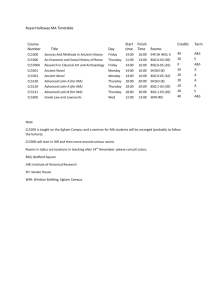


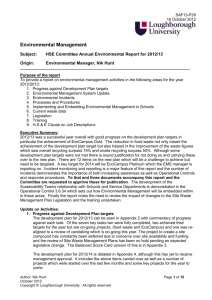

![School [recycling, compost, or waste reduction] case study](http://s3.studylib.net/store/data/005898792_1-08f8f34cac7a57869e865e0c3646f10a-300x300.png)
